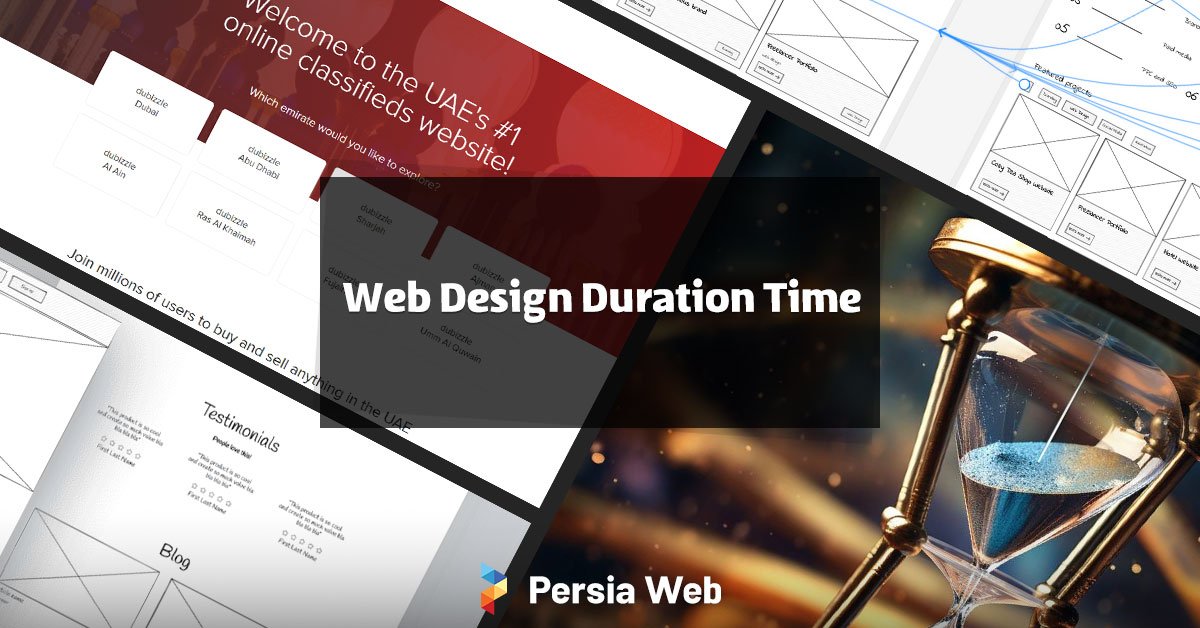In today’s digital world, having a professional and efficient website is essential for any business. However, before you proceed with ordering a website design, it is crucial to pay attention to key aspects of the contract. These points can significantly impact the final quality of the project and your satisfaction with the results. In this article from Persia Web, we will explore the key considerations that should be included in a website design contract, especially if you are in Dubai.
As a specialized company in web and app design, Persia Web creates comprehensive contracts that not only maintain high-quality standards but also ensure that all project details are clearly outlined and documented. Join us to learn more about these points and benefit from successful experiences in this field.
10 Key Sections of a Web Design Contract
1. Detailed Project Description and Requirements
One of the most important sections of the website design contract is the clear and detailed explanation of your project and its requirements. This section should specify the type of website you need and the purpose it will serve. All technical and content-related aspects must be covered comprehensively. For instance, if your website is an online store, all required features such as payment gateways, shopping carts, and inventory management systems should be clearly stated in the contract. Ignoring these details could lead to complications during the design and delivery phases.
In addition, all specific requirements that could affect the site’s performance must be clearly defined. This includes specifying whether your site will be built using a particular content management system (CMS), whether it should be responsive (i.e., display well on devices like phones and tablets), or whether search engine optimization (SEO) is part of the project.
Details such as the number of pages, features of each page, graphic design, colors, and even font preferences should be outlined in this section. Being specific from the start helps avoid unnecessary changes later and ensures that both you and the designer share a common understanding of the project and its needs.
2. Project Timeline
The contract should clearly state when the website design project will begin and when it will be completed. Although timelines may vary depending on the complexity of the project, establishing a clear deadline helps you plan accordingly. Additionally, the contract should outline penalties or consequences if the designers fail to complete the project within the agreed time frame.
3. Costs and Payment Terms
Another critical section is the breakdown of costs and payment terms. The total cost of the website design should be clearly specified, including details on each phase of the project, such as development, graphic design, SEO, and support. Moreover, the payment terms must be well-defined.
Different payment models for web design projects:
- Milestone-Based Payments (Standard Model): Payments are divided into stages according to the progress of the project. For instance, 30% of the total cost might be paid at the start of the project after signing the contract, another 30% after the design is approved, and the remaining 40% upon the final delivery and client satisfaction. This model ensures that the project progresses steadily and within the specified timeline.
- Monthly Installments (Long-Term Payment Model): The total cost is divided into several monthly payments. This model suits clients who prefer not to face heavy financial pressure at the beginning. Typically, payments are spread over six or twelve months, even after the website has been delivered.
- Two-Part Payment (Deposit and Final Payment): Half of the total cost is paid upfront at the start of the project, with the remaining amount paid upon final delivery. This straightforward method is ideal for short-term projects.
- Modular Payments (Based on Deliverables): Payments are made based on the delivery of key modules or parts of the website. For example, after each major section, such as the homepage or user management system, is delivered, the corresponding payment is made. This model is ideal for large and complex projects.
- Full Payment Upfront (Pre-Paid Model): The total cost is paid before the project begins. This method is often used for smaller or simpler projects where the client fully trusts the designer.
4. Deliveries and Reviews
In every website design project, the staging of deliveries and reviews is crucial. The contract should explicitly specify when the website will be handed over to you and at which stages you can request changes or reviews. Additionally, the number of revisions allowed at each stage should be clearly defined. Without a set limit on revisions, the project may overrun its timeline, leading to increased costs. Therefore, it’s essential to establish a specific number of reviews in the contract.
How Many Revisions Are Permitted in a Website Design Project?
Here are several review models commonly used in website design projects:
- Step-by-Step Review Model
In this model, after each phase of the project (such as the initial design, technical development, or final content addition), the deliverable is handed over, and the client has the opportunity to suggest revisions. The number of reviews per stage is limited, for example, one or two revisions per project phase. This model works well for projects with clear, phased milestones and helps prevent excessive changes at the project’s end.
- Limited Review Model
This approach limits the total number of revisions for the entire project. For instance, only two full reviews might be allowed for the entire project. This model is typically used when the client has a clear vision of the design and site features from the start. Although this model is more restrictive, it helps prevent unnecessary extra work and keeps costs under control.
- Unlimited Review within a Timeframe Model
In this model, the client can request unlimited revisions but within a set timeframe (e.g., two weeks after each stage is delivered). This method offers more flexibility to the client while ensuring that the project does not drag on unnecessarily. It is suitable for projects where frequent revisions might be needed but time control is also important.
- Final Review Model
In this model, only one review is conducted after the entire project is completed. The client receives the full site and has a single opportunity to request final changes and adjustments. This model is ideal for projects with a well-defined path from start to finish, requiring only minor updates. However, this approach demands a high level of trust between the client and designer, as limited revisions could risk client dissatisfaction.
- Modular Review Model
Here, the site is designed and delivered in modules, with each module reviewed individually by the client. This model suits projects with multiple distinct sections, such as a store, blog, and user management system. Each module is reviewed and approved separately, allowing the design team to move on to the next section. This method maintains order and speed in the project while giving the client the ability to review each part separately.
5. Intellectual Property and Usage Rights
The website design contract must clearly state who holds ownership of the site upon project completion. In simple terms, once you’ve fully paid for the website, all aspects of the site, including content, code, and graphic design, should transfer to you, making you the rightful owner.
However, some design companies may want to retain parts of their proprietary code or designs, limiting your full usage rights. For example, they may want to reuse the same code or design elements in future projects. You must ensure that all rights to the website, without any limitations, are granted to you in the contract.
Simple Example: Imagine you commission a painting. After you’ve paid for it in full, the painting is yours, and you can use it in any way you wish, even sell it to others. But if the artist doesn’t grant you reproduction rights, you can only enjoy the original painting but not reproduce or sell copies of it. The same applies to a website: you should ensure you own all rights to the site and its content, allowing you to use it as you see fit.
6. Technical Support and Maintenance for Website Design Projects
Once your website is launched, like any other tool, it may require maintenance and support to keep it running smoothly. Technical support ensures that if your site encounters issues or requires minor adjustments, the designer or support team will assist you.
Your website design contract should specify exactly what type of support you will receive. For example, will the support team fix technical problems? Will they assist with content updates or site improvements?
It’s important to understand whether this support is free of charge or if additional fees will apply for each service. Moreover, the contract should outline how long the support lasts—for example, six months of free support, after which extra fees may be charged.
Simple Example: Imagine you’ve purchased a car. If the car breaks down or needs servicing, you usually have a period of free maintenance. But after that period ends, you’ll need to cover the repair costs. Similarly, for your website, you need to know how long you’ll receive free support and what additional costs might arise afterward.
7. Search Engine Optimization (SEO)
One of the key factors in a website’s success is its visibility on search engines. Search engine optimization (SEO) helps your website rank higher in search results, attracting more visitors. Therefore, your website design contract should clearly state whether SEO services are included in the project.
If SEO services are part of the agreement, it should detail what kind of optimization will be provided. This may include optimizing page content, selecting appropriate keywords, optimizing images, and adding internal links. It is also important to clarify how the site’s search engine rankings will be tracked and improved. Including these details in the contract ensures that your website is designed from the start to attract visitors and perform well in search engines.
Simple Example: Suppose you run an online clothing store and hire a website designer. If SEO is not included in the contract, your site might not rank well in search results, making it difficult for potential customers to find you. For instance, if someone searches for “women’s clothing,” your site may not appear on the first pages if it’s not optimized. By including SEO in the contract, you ensure your site is designed to be visible in search results, helping you attract more customers and boost sales.
8. Termination Conditions
In any contract, it is essential to define the terms under which it can be terminated. This clause allows both you and the web designer to legally cancel the contract if you are not satisfied with the progress of the project or if one party fails to meet its obligations. Therefore, a website design contract should clearly outline the circumstances under which you can terminate the agreement.
These conditions may include issues such as failure to deliver the project on time, failure to make payments on schedule, or the project not meeting the initial requirements. For instance, if the designer is expected to deliver your website within a specific time frame but fails to do so, you have the right to terminate the contract.
Additionally, the contract should specify how much of the payments you’ve made will be refunded in the event of termination and whether any penalties will apply to either party. Addressing these points helps prevent future disputes and assures both parties that their rights are protected.
Simple Example:
Imagine you have a contract with a designer to build your website within two months. After a month, if the designer hasn’t delivered even one page and you are unsatisfied with the progress, you have the right to terminate the contract. The contract should also clarify whether you can reclaim all the money you’ve paid or only a portion of it, as well as the consequences if you fail to meet your own obligations, such as late payments. This way, both parties know what options they have if problems arise and how they can protect their interests.
Types of Termination Conditions in Website Design Contracts
- Termination due to Late Delivery: If the designer cannot deliver the project within the agreed timeline, the client has the right to terminate the contract. This condition should be clearly stated in the contract, for example, if there is more than a week’s delay.
- Termination due to Non-Compliance with Requirements: If, upon delivery, the website does not meet the client’s initial needs or expectations, the client can terminate the contract. This clause should include specific details of what constitutes non-compliance.
- Termination Due to Non-Payment: If the client fails to make payments on time, the designer has the right to terminate the contract. In such cases, the contract should specify how much time is allowed for payment and what the consequences are for late payments.
- Termination for Legal Reasons: If one party cannot fulfill their obligations for legal reasons (such as bankruptcy or violation of laws), the other party can terminate the contract. This condition should be clearly outlined in the contract.
Penalties and Refunds
- Penalty for Late Delivery: If the designer fails to deliver the project on time, they may be obligated to pay a penalty, which could be a percentage of the total contract value. For instance, a penalty of 5% of the total contract price might be applied for each week of delay.
- Refunds in Case of Termination: If the client terminates the contract due to non-delivery or non-compliance, a percentage of the payments made should usually be refunded. Typically, this refund can range from 70% to 100% of what has been paid, depending on the project’s progress and contract terms.
- Penalty for Non-Payment: If the client fails to meet their financial obligations, they may be required to pay a penalty, which can be a percentage of the outstanding amount. For example, the contract may specify that if a payment is delayed by more than 15 days, the client must pay a 2% penalty for each month of delay.
- Mutual Obligations: If one party terminates the contract, they must fulfill their obligations to the other party. For instance, if the designer terminates the contract due to non-payment, they should still provide the client with all the work completed up to that point.
9. Privacy and Security in Web Design Projects
In today’s digital world, data security is one of the top concerns. Your website may collect sensitive information from users, and it is crucial to ensure that this data is fully protected. The contract should specify what measures will be taken to safeguard user information and how sensitive data will be securely managed. It should also outline what precautions will be in place to prevent hacking and cyber-attacks.
For example, the contract may include details on the use of security protocols like HTTPS and data encryption. It should also clarify what measures will be taken to protect the site from hacks and cyber-attacks, such as firewalls, antivirus software, and regular security audits.
Additionally, the contract should inform users about how their data will be used and whether it will be shared with any third parties. These provisions will assure users that their data is secure and that their privacy is respected.
Simple Example:
Imagine you run an e-commerce website that collects credit card information from users. If your website is hacked and there are no security provisions outlined in the design contract, user data could be compromised, and you, as the website owner, could be held legally responsible. Therefore, specifying security and privacy measures in the contract protects both your rights and those of your users.
10. Training and Documentation
Once your website project is completed, it is crucial to be able to manage it easily. This means knowing how to update content, add new pages, or even solve minor issues. Therefore, the contract should specify whether the web designers will provide you with the necessary training to use the Content Management System (CMS).
Moreover, having comprehensive documentation on how to use and maintain the website is vital. These documents could include guides on how to use the management panel, update content, configure security settings, and everything else you need to manage your site efficiently. For example, a simple guide on how to add new posts or manage user comments can be included.
Does Website Management Training Come at a Cost?
It depends on your agreement with the designer. Some designers offer these services for free, and the contract will specify that after delivery, you will receive one or more training sessions. In such cases, documentation is usually provided free of charge as well.
However, in some cases, designers may charge a separate fee for training and documentation. This could be billed hourly or as a fixed amount for a set of training sessions. Therefore, be sure to clarify this before signing the contract and confirm whether any costs for training and documentation will apply.
Simple Example:
Imagine you have an online store, and the designer tells you that after delivery, they will hold a one-hour training session to help you update your products easily. They also provide a PDF manual that explains how to manage the admin panel. If these services are specified in the contract at no extra cost, you can comfortably manage your website. However, if the designer asks for an additional fee for each training session, it’s better to discuss this matter and reach a mutual agreement before proceeding.
Conclusion
In conclusion, paying attention to key elements in a website design contract can prevent misunderstandings and ensure the quality of the final project. Persia Web, a company specializing in website and app development in Dubai, is committed to maintaining transparency and accuracy in all contract stages. By collaborating with Persia Web, you can enjoy a professional and reliable experience, knowing that every project detail will be well-documented and managed properly.









